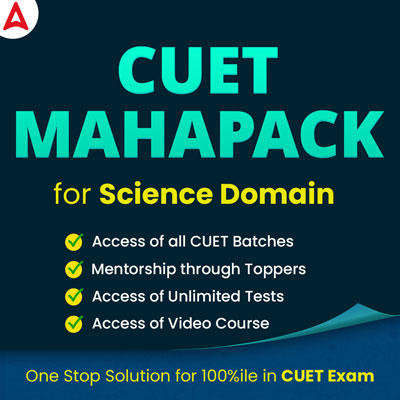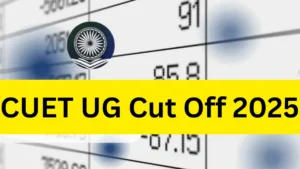Table of Contents
The CUET Physics Syllabus 2025 covers chapters and subjects from the Class 12 board exam curriculum. The National Testing Agency publishes the CUET UG Physics Syllabus 2025 on its official website at https://exams.nta.ac.in/CUET-UG/. If you want to pursue higher education in Physics at your favorite college, the CUET admission exam is your best option. Students preparing for the exam should have a solid understanding of the Physics course. The NTA will deliver the CUET UG 2025 Physics test between May 8 and June 1, 2025. You can download the CUET Physics curriculum PDF from this page, preparation tips, and last one-month strategy by following the approved curriculum.
CUET Physics Syllabus 2025
Understanding the CUET Physics Syllabus is the pillar for candidates who want to pursue higher education in the Physics domain. The CUET Syllabus contains all of the units that will be covered in the CUET Physics exam. CUET applicants in the Physics area must thoroughly review the CUET Physics Syllabus before beginning the complete phase of CUET preparation. To learn more about the CUET UG Physics Exam and the kind of questions asked, applicants should refer to the CUET Previous Years’ Question Papers.
CUET Physics Exam Pattern 2025
The Common University Entrance Test (CUET) 2025 is held for students who are pursuing undergraduate admission to Central Universities. There are three sections in the CUET Exam Pattern. Section I covers General Language paper, Section II cover 23 Domain-specific Subjects, and Section III cover the General Test (now known as General Aptitude Test).
The CUET Section-II comprises examinations on all domain-specific subjects. Physics is covered in Section II. Physics question papers have 50 compulsory multiple choice questions. The CUET Physics exam has a full marks of 250 . The physics exam will now be held for 60 minutes in online mode. Candidates can check latest revision made to CUET Physics syllabus below.
Physics CUET Syllabus 2025 Overview
The table below contains important information about the CUET Physics Exam and its exam pattern.
| CUET UG Physics Syllabus Overview | |
| Exam conducting body | National Testing Agency |
| Examination Name | Common Universities Entrance Test (CUET UG 2025) |
| Medium of Examination | 13 Languages (English, Kannada, Hindi, Punjabi, Marathi, Tamil, Urdu, Malayalam Odia, Assamese Telugu, Bengali and Gujarati ) |
| Examination Mode | Computer-based Test (CBT) |
| Time allotted for Physics Exam | 60 minutes |
| Total number of questions in the Physics section |
50 questions |
| Total Physics Questions to be Answered | 50 questions |
| Total Marks in Physics Section | 250 Marks |
| Marking Scheme | Marks per correct answer: +5 Marks per the wrong answer: -1 Marks per unanswered questions: 0 |
CUET UG Physics Syllabus 2025 Unit Wise
Physics is widely regarded as one of the toughest disciplines in the PCM branch. The CUET Physics Syllabus is made up of ten units. Atoms and Nuclei, Electrostatics, Current Electricity, Magnetic Effect of Current and Magnetism, Electromagnetic Induction and Alternating Current, Optics, Electromagnetic Waves, Electronic Devices, Dual Nature of Matter and Radiation, and Communication Systems are among the topics covered in the CUET Physics syllabus. Let us now go over the ten units of the CUET Physics Syllabus in detail.
Unit I: Electrostatics
• Electric charges and their conservation. Coulomb’s law – force between two point charges, forces between multiple charges; superposition principle, and continuous charge distribution.
• Electric field, electric field due to a point charge, electric field lines; electric dipole, electric field due to a dipole; torque on a dipole in a uniform electric field.
• Electric flux, statement of Gauss’s theorem and its applications to find field due to an infinitely long straight wire, uniformly charged infinite plane sheet, and uniformly charged thin spherical shell (field inside and outside).
• Electric potential, potential difference, electric potential due to a point charge, a dipole, and system of charges; equipotential surfaces, the electrical potential energy of a system of two point charges, and electric dipoles in an electrostatic field.
• Conductors and insulators, free charges, and bound charges inside a conductor. Dielectrics and electric polarization, capacitors and capacitance, the combination of capacitors in series and in parallel, the capacitance of a parallel plate capacitor with and without dielectric medium between the plates, energy stored in a capacitor, Van de Graaff generator.
Unit II: Current Electricity
• Electric current, the flow of electric charges in a metallic conductor, drift velocity and mobility, and their relation with electric current; Ohm’s law, electrical resistance, V-I characteristics (linear and non-linear), electrical energy and power, electrical resistivity, and conductivity.
• Carbon resistors, colour code for carbon resistors; series and parallel combinations of resistors; temperature dependence of resistance. The internal resistance of a cell, potential difference, and emf of a cell, the combination of cells in series and in parallel.
• Kirchhoff ’s laws and simple applications. Wheatstone bridge, metre bridge.
• Potentiometer – principle, and applications to measure potential difference, and for comparing emf of two cells; measurement of internal resistance of a cell.
Unit III: Magnetic Effects of Current and Magnetism
• Concept of the magnetic field, Oersted’s experiment. Biot – Savart law and its application to the current carrying circular loop.
•Ampere’s law and its applications to an infinitely long straight wire, straight and toroidal solenoids. Force on a moving charge in uniform magnetic and electric fields. Cyclotron. Force on a current-carrying conductor in a uniform magnetic field. The force between two parallel current-carrying conductors – definition of ampere. Torque experienced by a current loop in a magnetic field; moving coil galvanometer – its current sensitivity and conversion to ammeter and voltmeter.
• Current loop as a magnetic dipole and its magnetic dipole moment. The magnetic dipole moment of a revolving electron. Magnetic field intensity due to a magnetic dipole (bar magnet) along its axis and perpendicular to its axis. Torque on a magnetic dipole (bar magnet) in a uniform magnetic field; bar magnet as an equivalent solenoid, magnetic field lines; Earth’s magnetic field and magnetic elements.
•Para-, dia- and ferromagnetic substances, with examples. Electromagnets and factors affecting their strengths. Permanent magnets.
Unit IV: Electromagnetic Induction and Alternating Currents
•Electromagnetic induction; Faraday’s law, induced emf and current; Lenz’s Law, Eddy currents. Self and mutual inductance.
•Alternating currents, peak and rms value of alternating current/voltage; reactance and impedance; LC oscillations (qualitative treatment only), LCR series circuit, resonance; power in AC circuits, wattless current. AC generator and transformer.
Unit V: Electromagnetic Waves
•Need for displacement current. Electromagnetic waves and their characteristics (qualitative ideas only).
• Transverse nature of electromagnetic waves.
• Electromagnetic spectrum (radio waves, microwaves, infrared, visible, ultraviolet, x-rays, gamma rays) including elementary facts about their uses.
Unit VI: Optics
• Reflection of light, spherical mirrors, mirror formula. Refraction of light, total internal reflection, and its applications, optical fibres, refraction at spherical surfaces, lenses, thin lens formula, lens maker’s formula. Magnification, power of a lens, combination of thin lenses in contact combination of a lens and a mirror. Refraction and dispersion of light through a prism.
Scattering of light–blue colour of the sky and reddish appearance of the sun at sunrise and sunset.
• Optical instruments: Human eye, image formation, and accommodation, correction of eye defects (myopia and hypermetropia) using lenses.
• Microscopes and astronomical telescopes (reflecting and refracting) and their magnifying powers.
• Wave optics: Wavefront and Huygens’ principle, reflection, and refraction of plane wave at a plane surface using wavefronts.
•Proof of laws of reflection and refraction using Huygens’ principle.
Interference, Young’s double hole experiment and expression for fringe width, coherent sources, and sustained interference of light.
• Diffraction due to a single slit, width of central maximum.
• Resolving the power of microscopes and astronomical telescopes. Polarisation, plane polarised light; Brewster’s law, uses of plane polarised light and Polaroids.
Unit VII: Dual Nature of Matter and Radiation
•Photoelectric effect, Hertz and Lenard’s observations; Einstein’s photoelectric equation – particle nature of light.
• Matter waves – wave nature of particles, de Broglie relation. Davisson-Germer experiment
(experimental details should be omitted; only the conclusion should be explained.)
Unit VIII: Atoms and Nuclei
• Alpha – particle scattering experiment; Rutherford’s model of atom; Bohr model, energy levels, hydrogen spectrum. Composition and size of nucleus, atomic masses, isotopes, isobars; isotones.
• Radioactivity – alpha, beta, and gamma particles/rays, and their properties; radioactive decay law. Mass energy relation, mass defect; binding energy per nucleon and its variation with mass number; nuclear fission and fusion.
Unit IX: Electronic Devices
Energy bands in solids (qualitative ideas only), conductors, insulators, and semiconductors;
semiconductor diode – I-V characteristics in forward and reverse bias, diode as a rectifier; I-V characteristics of LED, photodiode, solar cell, and Zener diode; Zener diode as a voltage regulator. Junction transistor, transistor action, characteristics of a transistor; transistor as an amplifier (common emitter configuration) and oscillator. Logic gates (OR,AND, NOT, NAND and NOR). Transistor as a switch.
Unit X: Communication Systems
Elements of a communication system (block diagram only); bandwidth of signals (speech, TV, and digital data); bandwidth of transmission medium. Propagation of electromagnetic waves in the atmosphere, sky, and space wave propagation. Need for modulation. Production and detection of an amplitude-modulated wave.
CUET Physics Syllabus 2025 PDF Download
CUET Physics Syllabus pdf is available on the official website of CUET i.e cuet. samarth. ac.in. Candidates can download the CUET Physics Syllabus 2025 pdf from the official site. For the benefits, here have provided the CUET Physics Syllabus pdf in the below link.
CUET Physics Exam Pattern 2025
| CUET UG Physics Exam Pattern 2025 | |
| Particulars | Details |
| Types |
Multiple Choice Questions (MCQs)
|
| Total Questions |
50 questions (all compulsory to answer)
|
| Duration | 60 minutes |
| CUET Subject Mapping for Physics |
|
| Negative marking | Yes |
| Maximum Score | 250 |
|
Marking Scheme
|
|
CUET UG Physics Syllabus 2025 Preparation Books
To get good grades on the CUET Physics Test, you should study certain reference books in addition to standard literature. Below, our Adda247 CUET Faculty recommend several useful reference books for the CUET Physics Syllabus.
- NCERT Class 12th Physics Books
- Concepts of Physics by HC Verma
- Objective Physics by D.C. Pandey
- Fundamentals of Physic (Halliday, Resnick, and Walker)
CUET UG Physics Exam Preparation Tips
Candidates intending to take the CUET UG 2025 exam in the Science group need to study Physics to achieve a high score in the test. They can consult the preparation tips listed below for CUET Physics Preparation 2025.
- Familiarize Yourself with the Syllabus: Obtain a syllabus and identify the subjects that you need to learn. This will assist you in concentrating on what truly matters.
- Develop a Study Schedule: Formulate a timetable that allocates your study hours across various subjects. Remain committed to address the entire content.
- Utilize Quality Texts: Select textbooks and manuals that clarify concepts effectively. Some well-known options are NCERT textbooks for 11th and 12th grades.
- Practice Exercises: Tackle as many practice exercises as possible. This aids you in becoming acquainted with the kinds of questions you may encounter.
- Review Frequently: Revisit the subjects you’ve learned at intervals. This will aid in strengthening your memory and comprehension.
- Address Uncertainties: If you have queries or encounter confusion, consult your teacher or seek clarifications on the internet. Avoid accumulating uncertainties.
- Attempt Practice Exams: Consider doing mock tests in an exam-like setting. This will assist you in becoming familiar with the format and improving your time management.
- Stay Well: Ensure you obtain adequate rest, maintain a nutritious diet, and allow time for breaks. A fit body enables you to maintain focus and improve your learning.
CUET Physics Preparation Strategy
The cute Physics paper is of moderate to difficult level, so well well-organized strategy is necessary for complete revision of the CUET Physics Syllabus 2025. Check the step by step preparation strategy for physics paper here – CUET UG Physics Preparation Strategy.




 CUET Cut Off 2025, College-wise and Cour...
CUET Cut Off 2025, College-wise and Cour...
 CUET UG Date Sheet 2025 @cuet.nta.nic.in...
CUET UG Date Sheet 2025 @cuet.nta.nic.in...
 CUET Anthropology Question Paper 2025, D...
CUET Anthropology Question Paper 2025, D...




